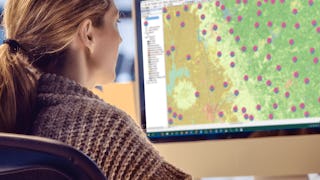The "Mastering Geospatial Analysis with QGIS" course employs a multi-disciplinary approach, covering essential aspects of geospatial analysis and QGIS software through nine structured modules. Module One introduces learners to QGIS, encompassing installation, QGIS 3.0 basics, and interface exploration including toolbars, panels, and plugins. Module Two focuses on practical geospatial data handling within QGIS, covering shapefiles, vector and raster data styling, and attribute management using calculators and selection tools. Module Three explores cartographic techniques such as coordinate systems, projections, and map creation including choropleth and graduated symbol maps. Additionally, it includes data integration tools like basemaps, GPS data handling, and measurement tools. Module Four delves into georeferencing and digitization methods for toposheets and online sources like Open Street Maps and Google Earth. Advanced spatial analysis techniques like buffer and overlay analysis are detailed in Module Six, while Modules Seven to Nine cover satellite data handling, terrain analysis, and advanced mapping and application development using QGIS and tools like Qfield and BIM integration. Join us in mastering QGIS for geospatial analysis and applications development, preparing to excel in this dynamic field.
通过 Coursera Plus 解锁访问 10,000 多门课程。开始 7 天免费试用。


Mastering Geospatial Analysis with QGIS
本课程是 Geospatial Techniques for Engineers 专项课程 的一部分
4,174 人已注册
包含在 中
您将学到什么
Learn QGIS basics, data formats, and practical skills for handling vector/raster data and using tools like Field Calculator.
Master map styling, georeferencing, and digitization, including creating choropleth maps and integrating GPS data.
Explore advanced spatial analysis, satellite data classification, terrain modeling, and geospatial application development with QGIS.
您将获得的技能
要了解的详细信息

添加到您的领英档案
9 项作业
了解顶级公司的员工如何掌握热门技能

积累特定领域的专业知识
- 向行业专家学习新概念
- 获得对主题或工具的基础理解
- 通过实践项目培养工作相关技能
- 获得可共享的职业证书

该课程共有9个模块
This module introduces the fundamentals of QGIS (Quantum GIS), a popular open-source Geographic Information System software. Learners will be guided through the installation process of QGIS 3.0, exploring its features and graphical user interface (GUI) components such as toolbars, panels, and plugins.
涵盖的内容
8个视频3篇阅读材料1个作业1个讨论话题
This module focuses on practical skills for working with geospatial data in QGIS. Learners will learn to download and work with shapefiles, including styling vector and raster data. The module also covers handling attribute data using tools like the Field Calculator and selecting features within QGIS.
涵盖的内容
7个视频1个作业1个讨论话题
This module covers cartographic techniques and tools available in QGIS for map representation and styling. Learners will explore coordinate systems, projections, and create various thematic maps such as choropleth, graduated symbol, heat maps, and dot distribution maps. Additionally, the module covers map layout techniques and essential data integration and analysis tools within QGIS.
涵盖的内容
11个视频1个作业1个讨论话题
This module focuses on georeferencing and digitization techniques using QGIS. Learners will understand the process of georeferencing toposheets, including downloading and setting transformation parameters. They will also explore digitization techniques for creating point, polyline, and polygon datasets from toposheets.
涵盖的内容
11个视频1个作业1个讨论话题
This module focuses on advanced techniques for digitizing and georeferencing spatial data from online sources using QGIS. Learners will explore methods for digitizing point, polyline, and polygon datasets from OpenStreetMap and Google Earth images. The module covers downloading and georeferencing Google Earth images, and using the QuickMapServices plugin for accessing map data.
涵盖的内容
9个视频1个作业1个讨论话题
This module explores advanced spatial analysis techniques available in QGIS. Learners will delve into buffer analysis methods including multi-distance buffers, overlay analysis techniques, and network analysis using tools like the ORS (OpenRouteService) plugin. The module equips learners with skills to perform sophisticated spatial analyses for diverse applications.
涵盖的内容
9个视频1个作业1个讨论话题
This module focuses on acquiring and classifying satellite data using QGIS. Learners will explore various satellite data downloaders including USGS, Copernicus, NASA Earth Data Search, and Bhuvan. The module covers supervised classification techniques using the Maximum Likelihood Algorithm, unsupervised classification methods such as K means clustering, and temporal analysis techniques for change detection.
涵盖的内容
14个视频1个作业1个讨论话题
This module covers terrain analysis and surface modeling techniques using QGIS. Learners will explore elevation and slope analysis, hillshade, aspect, contour generation, watershed analysis, surface analysis, viewshed analysis, and profiling and cross-sectioning techniques for detailed spatial analysis and visualization.
涵盖的内容
10个视频1个作业1个讨论话题
This module explores advanced topics in geospatial mapping and application development using QGIS. Learners will learn techniques for extracting building footprints, creating 3D maps, and developing web and mobile maps. The module also covers integrating QGIS with Building Information Modeling (BIM) for creating digital twins.
涵盖的内容
8个视频1个作业1个讨论话题
获得职业证书
将此证书添加到您的 LinkedIn 个人资料、简历或履历中。在社交媒体和绩效考核中分享。
位教师

提供方
从 Environmental Science and Sustainability 浏览更多内容
 状态:免费试用
状态:免费试用L&T EduTech
 状态:免费试用
状态:免费试用University of California, Davis
 状态:免费试用
状态:免费试用L&T EduTech
人们为什么选择 Coursera 来帮助自己实现职业发展




常见问题
To access the course materials, assignments and to earn a Certificate, you will need to purchase the Certificate experience when you enroll in a course. You can try a Free Trial instead, or apply for Financial Aid. The course may offer 'Full Course, No Certificate' instead. This option lets you see all course materials, submit required assessments, and get a final grade. This also means that you will not be able to purchase a Certificate experience.
When you enroll in the course, you get access to all of the courses in the Specialization, and you earn a certificate when you complete the work. Your electronic Certificate will be added to your Accomplishments page - from there, you can print your Certificate or add it to your LinkedIn profile.
Yes. In select learning programs, you can apply for financial aid or a scholarship if you can’t afford the enrollment fee. If fin aid or scholarship is available for your learning program selection, you’ll find a link to apply on the description page.
更多问题
提供助学金,




